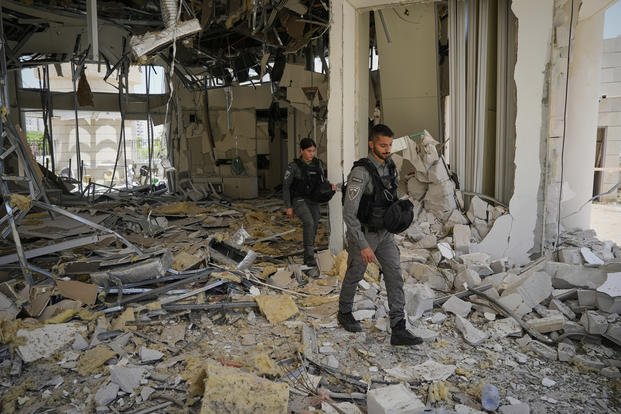
Despite increasingly heated rhetoric on Iran coming from President Donald Trump on Tuesday, U.S. officials said the Pentagon had not made any new, major force posture changes in the Middle East in the past 24 hours and the mission for troops remained protecting U.S. assets — not conducting strikes.
Israel for days had conducted missile strikes on Iran, including hitting its state media broadcaster in Tehran, and appeared set on destroying its nuclear program, potentially with the help of the U.S. Trump, who initially appeared open to dialogue with the Iranians, turned to more aggressive rhetoric threatening the Iranian supreme leader, warning residents of Tehran to evacuate, and appearing to demand “unconditional surrender” in a social media post, though the U.S. position remained unclear Tuesday afternoon.
The Pentagon had already announced it was moving destroyers and tanker aircraft into the region and hurrying the deployment of an aircraft carrier. A U.S. official told Military.com on Monday that the aircraft carrier USS Nimitz is moving to the Middle East to join the carrier USS Carl Vinson and its strike group, which are nearing the end of a deployment.
Read Next: Military Moves Ships, Aircraft to Middle East as Senator Seeks to Stop US Action Against Iran
“We now have complete and total control of the skies over Iran,” Trump posted on his social media platform Truth Social on Tuesday, adding that the U.S. knows “exactly where the so-called ‘Supreme Leader’ is hiding. He is an easy target, but is safe there — We are not going to take him out (kill!), at least not for now.”
Two U.S. officials told Military.com on Tuesday there were no U.S. military assets flying over Iran but deferred any further questions about the president’s posts to the White House.
Military.com reached out to the White House for more context on Trump’s posts but did not hear back in time for publication.
On Monday, Military.com reported that the Navy has not only rushed another aircraft carrier, the USS Carl Vinson, to the region but also positioned an additional ballistic missile defense-capable destroyer off the coast of Israel.
The military has also moved a host of tanker aircraft toward the region as well. Those aircraft could be utilized to refuel bombers traveling from the U.S. mainland to the Middle East.
The pair of U.S. officials who spoke with Military.com said that no other major moves have been made since that report.
One official explained that there were already a number of air assets in the region for Operation Rough Rider — the military’s effort to degrade attacks by Yemen’s Houthi rebels on shipping in the Red Sea.
The official added that, following Defense Secretary Pete Hegseth’s orders to deploy additional capabilities, a couple of squadrons of jets were moved into the region. Other squadrons were placed on “prepare to deploy orders.”
However, the same official also confirmed that the handful of B-2 Spirit stealth bombers that were deployed to Diego Garcia, an island in the Indian Ocean, in the spring have been withdrawn.
Late Monday, officials at the Pentagon also took to social media to stress the defensive nature of their actions.
Sean Parnell, the Pentagon’s top spokesman, said that “American forces are maintaining their defensive posture and that has not changed” in a post to social media.
Hegseth also released a statement in which he confirmed that he “directed the deployment of additional capabilities” to the Middle East but stressed that the deployments “are intended to enhance our defensive posture.”
He did not offer any details on what all the additional capabilities were.
Both U.S. officials who spoke with Military.com stressed that diplomacy was the No. 1 priority in the region and that, while there were more military assets being moved into the region, all of them had defensive capabilities.
However, given that the military has a full carrier strike group — composed of an aircraft carrier, guided missile cruiser and three destroyers — in the northern Arabian Sea, as well as a number of air assets lingering from Operation Rough Rider, there is no shortage of capability should a strike be ordered.
Amid the rising tensions, lawmakers have begun to speak out and argue that Congress should be consulted on any offensive military action against Iran.
“I am deeply concerned that the recent escalation of hostilities between Israel and Iran could quickly pull the United States into another endless conflict,” Sen. Tim Kaine, D-Va., said in a statement Monday as part of announcement for a war powers resolution he introduced. “The American people have no interest in sending service members to fight another forever war in the Middle East. This resolution will ensure that, if we decide to place our nation’s men and women in uniform into harm’s way, we will have a debate and vote on it in Congress.”
Two congressmen, Rep. Thomas Massie, R-Ky., and Rep. Ro Khanna, D-Calif., introduced a similar war powers resolution in the House of Representatives on Tuesday.




